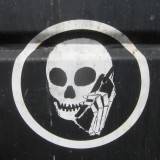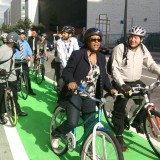
P32 investigates a camera, February 2015 (National Park Service)
On August 10 of this year, sometime in the early morning, a young mountain lion known to us as P32 was killed on the Interstate 5 near Castaic.
He had been tracked by researchers for two years–and appeared on the local news now and then– as he traversed the borderlands of our civilization, crossing our roads and slinking through our backyards as he made his way from wild space to wild space, traveling all the way from the Santa Monica Mountains to Pyramid Lake. Cameras caught him making four freeway crossings in the past, and certainly he made more He had to cross highways. An adult mountain lion needs about 200 miles of home range to make a living.
State officials call his death “Sad, but not surprising.”
On August 10th, P32 became “roadkill.” Roadkill is an odd term, isn’t it? The road didn’t kill P32, a driver did.
There’s some odd blameshifting going on there. The term roadkill implies that no one is at fault. It also seems to indicate that roads will kill, inevitably, and any creature hit by a car was stupid to be on the road in the first place. They should know the rules: step on our roads and you die.
After the collision, the animal is denigrated by the means of its death to a nonentity. P32 ceased to be a lion and became roadkill–and roadkill is a joke.
How big of a joke? According to the Humane Society, one million animals die on U.S. roads every day.
Yes, one million every day.
It’s a hard number to get your head around. It’s a hard number to come to, because most animal deaths are not reported. Animals tend to make the stats only if they’re large enough to damage a vehicle, or must be dragged from the road to clear the way for traffic. No one is counting all of the flattened rabbits and possums and squirrels and the sparrows and turtles and snakes, so I’m not sure how the Humane Society is calculating this number, but I don’t doubt it. It’s probably low.
And what about insects?
Researchers in the Netherlands estimate that 800 billion insects die on the hoods of automobiles every six months in the Netherlands alone. British research brings in similar numbers in terms of bugs killed per distance traveled. Treehugger extrapolated that number for the US, and reckons we kill about 32 trillion insects a year while driving.
(An aside, I once heard Emily Green comment that planting the median strip of a busy boulevard with flowers was like parking an ice cream truck in the middle of a freeway. In other words, how many pollinators die trying to cross traffic to get to our beautified medians? Talk about being killed by good intentions.)
How much of the food supply for birds and frogs and other creatures is lost on our hoods and under our wheels? And while few people would mourn the passing of a mosquito or a fly on the windshield, but what about the night pollinating moths, what about the Monarchs, what about the bees?
We’re all up in arms about CCD, about pesticides and dying pollinators–how many bees are we killing all by ourselves as we drive?
In the same way, we decry shelters which euthanize dogs and cats, we abhor animal testing, but we kill more animals on the roads than we do in the shelters and the labs.
But let’s get more anthropocentric. What about human deaths?
In 2013, in the U.S. alone:
- 32,719 people died in car-related accidents (This number is significantly down from past years, but sadly seems to be going back up this year.)
- 4,735 of these were pedestrians (i.e. people trying to walk around–I kind of hate the word pedestrian) A further 22,000 people were injured by car drivers.
- 735 of the dead were cyclists
FYI, 3,551,332 people have died in the US in motor vehicle accidents since we invented cars. The chart of this year by year progression is grimly interesting. As is this chart of countries by traffic related death rates.
In sum, every year I’ve been alive, an average of 45,000 people have died–in the US alone–simply because they needed to get to work, or school or the store.
Why is it acceptable to us that so many people must die just because they needed to get somewhere? Do we live in a war zone? How many casualties are acceptable in this engagement?
And beyond the lives lost, there’s the money. The National Highway Traffic Safety Administration estimates that highway accidents cost $277 billion dollars a year in straight up economic costs ($900 per person in the US) and a more fuzzy $594 billion in “societal harm,” meaning pain suffered, decreased quality of life, etc. The total is $871 billion in losses per year.
And all of the above is simple an accounting of deaths and money. Stuff which isn’t abstract. Blood on the pavement is hard to spin. I haven’t touched on climate change, air pollution, noise pollution, light pollution, habitat loss, urban sprawl, songbird harassment–all of the rest of indicators of the unspeakably high cost of the personal automobile.
So, okay, this is all depressing. What’s my point?
The point is:
What are we thinking?
I mean, seriously, what are we thinking? Can we step back from this?
I doubt it. We can’t talk about giving up the personal automobile. We can’t even think about alternatives, no matter what it costs us, anymore than an Easter Islander could stop chopping down trees.
Our blindness is intractable, and all-encompassing. For us, cars are not merely a convenient transportation device of fairly recent invention. They are magical talismans. They represent us: our souls, our freedom and self-determination.
I don’t know if we can escape this kind of blindness. I speak for myself. I drive. I live in a car-centric city. I know better. And still I drive.
But I do wonder why, and I wonder what it is doing to our souls.
The road is an ugly place and it makes for ugly people. I was on the freeway today, and as usual had a few scary moments and did my obligatory bit of swearing at my fellow man. You’d think the roads were stuffed with sociopaths rather than decent people trying to get through their day. We change when we’re on the road.
We don’t look one another in the eye. We’re anonymous. We’re armored. We’re more powerful than we are on our feet, so we feel invincible.
Life, real life, good life, is about connection. Connection with ourselves, with nature, with spirit, with each other. It’s about relationships. And relationships are formed face to face. Our freeways and boulevards are places of anti-connection, anti-relationship. Taken out of the cradle of connection, we turn into monsters.
The dead by the road, or on it, testify to the presence of man. Their little gestures of pain—paws, wings and tails—are the saddest, the loneliest, most forlorn postures of the dead I can imagine. When we have stopped killing animals as though they were so much refuse, we will stop killing one another.
But the highways show our indifference to death, so long as it is someone else’s. It is an attitude of the human mind I do not grasp. I have no point of connection with it. People drive in such a way that you think they do not believe in death. Their own lives are their business, but my life is not their business. I cannot refrain from terrific anger when I am threatened so casually by strangers on a public road. – Timothy Findley, from Journeyman: Travels of a Writer, 1965
If there were any grown-ups in this world, they’d take our cars from us, because we’ve been very bad with our toys.
I’ve been trying to be a grown-up. Which means I’ve been thinking about bicycling, even though I’m afraid to even get on a bike in this city. I feel like a huge hypocrite for not doing so, though, and the balance of moral incentive versus fear keeps tipping as I am forced, day by day, to acknowledge the costs of my behavior.
The death of P32 has pushed me a little further toward courage.
***
Note: If you’d like to help track animal road deaths so that a) we know the actual numbers and b) so we could maybe get some money together to build culverts or bridges for animals to use to cross highways, check out:
Roadkill Survey by Adventurers and Scientists for Conservation
And if you live in California or Maine:




This is one reason I get irate when people blame wind turbines for bird deaths; there are so many human artifacts that kill birds (windows, cars) that we would never consider eliminating.
True. And while, sometimes, we will make concessions to reduce window strikes, car strikes are “just the way it is” — unexamined, unchallenged.
I would love it if I could go everywhere by bike or on foot!!
You can. What is your excuse?
One death is a tragedy, a million deaths a statistic. I believe Stalin said that (or it has been attributed to him). Sad but true. The best most of us can do is be a good example and instill a sense of wonder, respect, and enjoyment with the natural world within those we can influence.
Hi Kelly,
I felt moved to write because of your reference to Easter Island. It is also mentioned in a wonderful book called What We Think About When We Try Not To Think About Global Warming: Toward A New Psychology of Climate Action by Per Espen Stoknes published by Chelsea Green Publishing.
He addresses exactly the question you ask: What are we thinking?
For the first time in a LONG time, I feel hope and possibility when it comes to climate change.
This just brought me one step further to the eventual purchase of a cargo bike.
I would LOVE an alternative to car travel. but in the midwest we are as car centric as you LA ppl. I would love to be able to bike, or even use a pony and cart. We recently watched a series from Denmark called ‘Borgen’, which I highly recommend. I love the bike culture there – in the series even high up government officials were biking to work.
If you want to learn how to bike in LA, try finding a Cycling Savvy course: http://cyclingsavvy.org/
If it pulls your heartstrings that an estimated 1 million animals die on our roads each day, you may want to consider that an estimated 10 billion die in slaughterhouses each year. It’s an unfathomable amount of suffering that really has no justification save for pleasure, habit, and convenience.
For your reading queue: http://www.amazon.com/Apologia-Barry-Lopez/dp/B000BZ99QA
“What are we thinking?” is a great way to put it.
I got home last night with no plan for dinner, grabbed some leeks and potatoes from garden, pulled some stock from the freezer and made soup. I initially thought “awesome job making this meal from your place!” Then I thought, the fact that you think making one last-minute meal from your place is awesome is the sign of a much deeper problem.
What would be awesome would be to get home, make potato and leek soup from the garden without a thought in the world, and spend creative time thinking up something awesome that wasn’t about something that should be as fundamental as the food supply; that should already have been handled.
The cultural shift necessary to live in our places is so monumental, who knows if it will ever happen.
BUT UNTIL THEN…I MADE POTATO LEEK SOUP AFTER WORK AND IT WAS AWESOME.
He has such a sweet face, he reminds me of my big orange Buddy. When death is casual, something is wrong with us all.
Given the choice of living in abject poverty in a 3rd world country with dirt roads, ox cart driven commerce and bicycles as a primary means of transportation or, living in the developed world with cars, trains and planes, I think I’ll take my chances on becoming road kill.
thank you for this researched, impassioned and sane post.
Thank you so much for this thought provoking essay. It was the most meaningful writing I’ve read today.
Please continue to add your voice regularly to Root Simple.
People need to slow the f*** down so that they can actually respond to what’s on the road. They only think they need to go fast because they have the means to do so and have spent years structuring their lives around that. I have found that the process of lowering my expectations when it comes to travel time isn’t some kind of exercise in aestheticism. My traveling experiences have only been improved by it.
But I’ve given up the car in favor of cycling. The costs of repairs, insurance, and registration finally got to me, and I had enough. Going cold turkey has been a very good experience so far. That’s thanks in no small part to having a comfortable and reliable bike that steers well with a load and has dynamo lighting, wide tires, and sturdy front and rear racks.
Thank you for this writing- it was very thought-provoking.
This is so sad! The attitude that “roadkill” is not really the same thing as the death of a living creature is so wrong.
I’ve been wondering why, in over 40 years of driving, I have never knowingly killed an animal. And I apologize to the many mice, snakes and smaller creatures that I may have unknowingly killed. It’s not that I’m a good driver, because I’m not. However, I am a careful driver. Most of my driving has been in rural and back country areas, and people who are not careful drivers here usually end up down a ravine or up a tree, which effectively solves one problem.
If you are driving in areas where the bush comes close to the road, you learn to watch out for signs of animals. If you don’t, the best that can happen to you is that you will hit a deer, which will severely damage your vehicle and maybe you, as well as killing the deer. The worst that can happen is that you will hit a moose or a fully-grown bear. In such cases, the “roadkill” toll is likely to include you.
Loud and clear, Kelly. There’s something profoundly true in the adage “if you aren’t part of the solution”…
I started bike commuting in my late 30’s after not having perched atop a bike in 20 years. Yes it took time to adjust and yes there can be a lot of route planning at the beginning, but I promise that once you’ve been at it a while it is the most free you’ll ever feel! And it helps with the cognitive dissonance that’s impossible to avoid as an informed North American. The way to transition to more bikeable communities is through volume. So putting your bike on the road is casting a ballot for a future with more diversity of transport. Go for it!
Thank you for this. There is much to think about here.